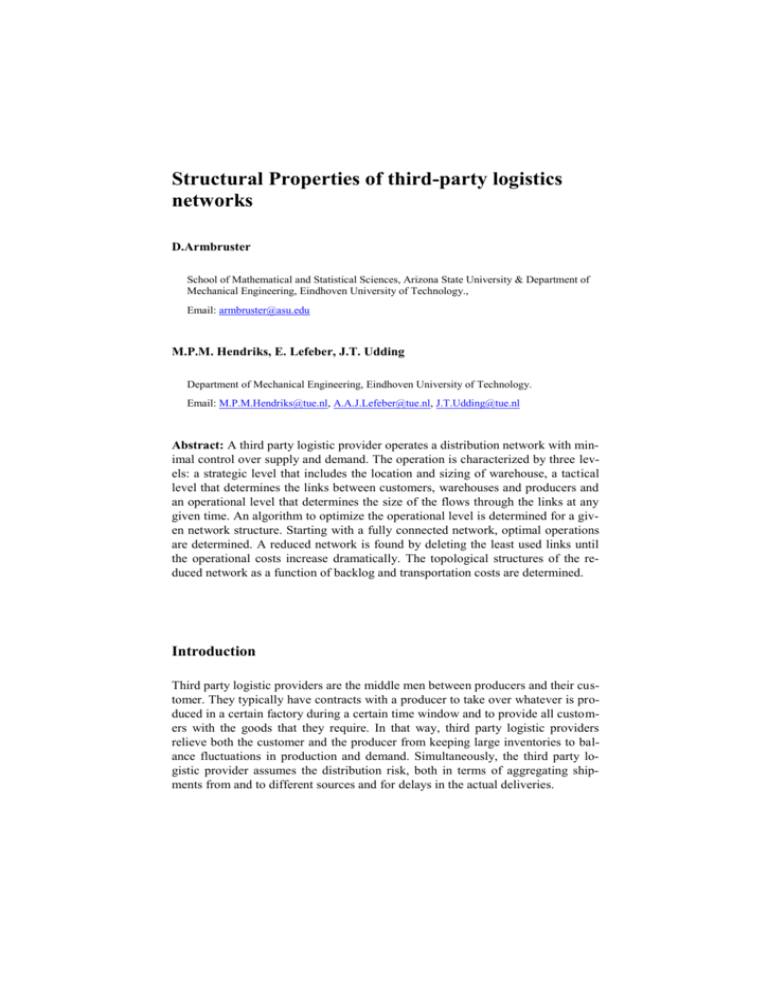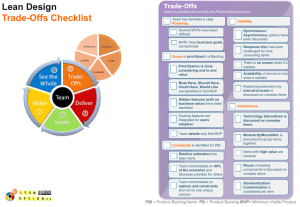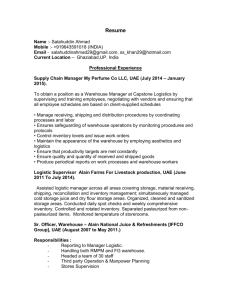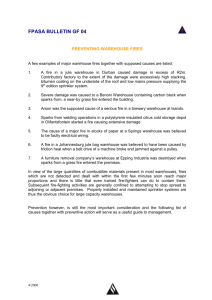doc - Arizona State University
advertisement

Structural Properties of third-party logistics networks D.Armbruster School of Mathematical and Statistical Sciences, Arizona State University & Department of Mechanical Engineering, Eindhoven University of Technology., Email: armbruster@asu.edu M.P.M. Hendriks, E. Lefeber, J.T. Udding Department of Mechanical Engineering, Eindhoven University of Technology. Email: M.P.M.Hendriks@tue.nl, A.A.J.Lefeber@tue.nl, J.T.Udding@tue.nl Abstract: A third party logistic provider operates a distribution network with minimal control over supply and demand. The operation is characterized by three levels: a strategic level that includes the location and sizing of warehouse, a tactical level that determines the links between customers, warehouses and producers and an operational level that determines the size of the flows through the links at any given time. An algorithm to optimize the operational level is determined for a given network structure. Starting with a fully connected network, optimal operations are determined. A reduced network is found by deleting the least used links until the operational costs increase dramatically. The topological structures of the reduced network as a function of backlog and transportation costs are determined. Introduction Third party logistic providers are the middle men between producers and their customer. They typically have contracts with a producer to take over whatever is produced in a certain factory during a certain time window and to provide all customers with the goods that they require. In that way, third party logistic providers relieve both the customer and the producer from keeping large inventories to balance fluctuations in production and demand. Simultaneously, the third party logistic provider assumes the distribution risk, both in terms of aggregating shipments from and to different sources and for delays in the actual deliveries. 2 The logistic network and flows resulting from such a business model are significantly different from a usual supply network. In particular, there is only a general framework specifying the location and number of producers as well as their average production rate and the location, number and demand rate of their customers. In contrast to a supply or a distribution network, there are no demands funneled up the supply chain from the customer to the producer. Here, producers request pickup of finished goods and customers request delivery at a certain time and it is the job of the third party logistic provider to store excess production and deliver requests on time. While there are long term contractual obligations to service specific producers and their customers, the actual quantities fluctuate stochastically and are only known a few days ahead of actual delivery. A typical scenario is the Just In Time production common in the automobile industry. Parts are produced by a big plastics company at different locations throughout Europe and needed at different assembly plants in Europe. Neither the plastics producer nor the assembly factory keep any sizeable inventory- however the customers expect delivery just in time for assembly. Keeping the right size inventory and shipping on time is the business of the third party provider. There are three management levels to operate a third party logistic provider: 1. At the strategic level the number of warehouses, their geographic location and the geographic range of the logistic network have to be determined. 2. At the tactical level transportation links between the established set of customers, producers and warehouses are set up 3. At the operational level size and direction of shipments are established. These three levels correspond to different timescales – warehouses and geographic operations correspond to long term plans and investments, the operational level covers day to day operations and the tactical level lives on a monthly to yearly timescale. The current paper is specifically concerned with the tactical level. We assume that the strategic decisions have been made and we assume a fixed set of warehouses, producers and customers. We are studying the network of links. In particular, we focus on the influence of the operational level on the network structure, i.e. we are interested to determine the topology of the network as a function of the operational parameters. We will study the influence of the following operational parameters on the tactical logistics networks: Cost of delivery at the wrong time. Typically there are contractual penalties for early or late delivery. The actual transportation costs – we assume costs that are linear in the amount that is shipped. Variation in demand and production. To determine the network structure we develop an optimization scheme that optimizes the operational level. Given a network structure, transportation cost coeffi- 3 cients, missed delivery penalties and given stochastic production and demand rates over a time interval, we will determine the optimal allocation of shipments to direct shipping and to warehousing. We then repeat the optimization for a network with a smaller number of links and continue this process until the costs for the logistic provider go up significantly. Establishing transportation links is costly: Local shippers have to be contracted, customs and other licensing issues may arise, etc. A reduction in the number of links reduces the complexity of the network and with that the complexity of the organizational task of the third party logistic provider. In addition reducing the number of links pushes the flow of goods into the remaining links leading to thicker flows which lead to economy of scales (more fully loaded trucks or railroad wagons). In principle, the economy of scales and the costs of establishing links could be put into a cost function and an optima link structure could be derived. However, the resulting optimization scheme will become extremely complicated and very hard to solve for any reasonable size network. In addition, the structural cost of establishing a link are very hard to quantify. Our study shows: 1. The cost of operating a third party logistic network can be quantified and optimized. 2. A heuristics is developed that reduces the number of links based on their usage. 3. As the number of links in a network is reduced the cost of running the operation on the network stays almost constant. Most links are redundant and can be deleted without any influence on the operation of the network until a critical network size and structure is reached. At that point the operational cost explode by several orders of magnitude reminiscent of a physical phase transition. Hence there exists a network with a very limited number of links that has close to optimal operational cost called the reduced network. 4. The reduced network is largely insensitive to variations in the production and the demand rate. 5. The parameters of the operational cost function determine the topological structure of the reduced network. In particular, just in time shipping requires direct links between some producers and some customers whereas time insensitive deliveries lead to a network where all links go through warehouses. This paper gives a short summary of our work: Details on the connection between the heuristics and exact optimization via a branch and bound algorithm, about the relationship between continuous production flows and transportation via trucks leading to a stepwise cost function, on extensions to more than one product flow and other issues can be found in [1] Related Approaches. 4 Some related work focuses on optimizing the strategic level: For instance [Mee07] determines the optimal number and location of warehouses, given the location of a plant producing one type of product and given the number and location of the customers. Results show that there is a tradeoff between the robustness of the network and its efficiency and its complexity [Cor06]. Typical studies investigating supply chain policies place orders to manufacturing facilities to keep inventory positions in warehouses at a desired level and to satisfy customer demand [Kwo06], [Hax84], [Wag04]. While the decision space on an operational level in a supply chain network is crucially different from the decision space for a third party logistic provider, some of the approaches are similar to ours. For instance [Tsia01] studies the strategic design of a multi-echelon, multi-product supply chain network under demand uncertainty. The objective is to minimize total costs taking infrastructure as well as operational costs into consideration. A finite set of demand scenarios is generated and the objective function is expanded by adding weighted costs for each of the possible scenarios. A process very similar to our heuristic process is employed in [Kwo06] to determin the number and locations of transshipment hubs in a supply chain network as a function of the product flows. The costs of operational activities in a network in which all potential hubs are present are minimized. Deleting one hub at a time the decrease in cost is determined and the hub which causes the largest decrease is deleted from the network. This process is continued until deleting a hub does not significantly affect the costs. The dependency of the operational costs in a multi-echelon supply chain on the number of warehouses connected to each customer is studied in [Che96]. In a standard distribution network, each customer desires to be connected to one warehouse for practical reasons. They suggest that large improvements are made when a portion of the customers is served by two warehouses (and the rest by one). An interesting recommendation for future research is investigating the sensitivity of the optimal network to the ratio of different operating costs. The most interesting work on optimizing the operations of a third party logistic provider is [Top05]. Here a company owns several production plants and has to distribute its goods to different regional markets. In each time period, a random (uncontrollable) amount of goods becomes available at each of these plants. Before the random amount of the customers becomes available, the company has to decide which proportion of the goods should be shipped directly and which proportion should to held at the production plants. Linear costs are assigned to transportation, storage and backlog. A look ahead mechanism is introduced by using approximations of the value function and improving these approximations using samples of the random quantities. It is numerically shown that the method yields high quality solutions. Again it is found that improvements for the operational costs are made when a part of the customers is served by two plants, while the other part is served by one. 5 Methodology To fix ideas we consider the graph in Figure 1: Production facilities supply goods and push them into the network while customers have a demand for them. Goods can be either sent directly from manufacturer(s) to customer(s) or stored temporarily in warehouses. We do not allow shipments from one warehouse to another. Fig. 1: A typical small logistic network.. We consider the following problem: Given m production facilities for the same product, n warehouses, c customers and their spatial location, and given a time series of daily production and daily demands at each location over a time period T, determine a network topology such that both, the costs of operating the network, and the number of links are close to minimal. We assume the total supply to be equal to the total demand over the time period T. The time series for production and demand are fixed and randomly generated. However, they are only known to the third party logistic provider (the optimization scheme) over a time horizon S where S<<T. We will set up an Linear Programming (LP) scheme, which describes the flows through such a logistics network for a fixed topology. The decision variables of 6 this model are the flows each day through each of the links. The modeling is in discrete time (days) and is based on the following conservation laws: i) Every day the production at each factory has to be distributed among the links, connected to that particular factory, ii) The storage level in a warehouse is updated daily, dependent on incoming and outgoing flows. Flows going through a warehouse incur a delay: Products arriving in a warehouse at a certain time instance are shipped out one day later. An objective function is constructed by assigning costs per unit of goods per day for transportation, storage and early and late delivery. The amount of goods, which are not delivered to a certain customer at a certain time instance, is added to the original demand of that particular customer for the next time instance. The conservation laws are equality constraints for this optimization problem. Since forecasts of supplies and demands are available over the time horizon S, routing decisions are based on this time horizon. This leads to a model predictive control (MPC) scheme with receding time horizon which is executed each day during the time period T. to determine the most cost-effective routing schedule for the given period T and the fixed network topology. Since the number of possible topologies grows very large when realistic values for $m$, $n$ and $c$ are considered we propose a heuristic to determine the network that has the lowest number of links while still generating a close to optimal schedule. Optimization Scheme for the operational level Let k = 0, 1, 2, 3 represent time in days, ui,j(k) to be the amount of goods transported from node i to node j on day k, and wp(k) to be the inventory position in warehouse p on day k. Although the total supply on day k can differ from the total demand on day k, we require that the following conservation law holds for period T: T k 0 m T c Mi(k ) Cj(k ) . i 1 (1) k 0 j 1 Here Mi(k) is the supply of facility i on day k and Cj(k) is the demand of customer j on day k. This assumption implies that the total amount of goods produced and consumed over the time period T is balanced. In addition Mi (k ) uij(k ) , jSi (2) 7 where the set Si contains the indices of all the nodes to which manufacturing facility i is connected. A similar constraint exists for the warehouse: wp (k ) wp 1(k ) uij(k 1) upj(k ) , iIp (3) jOp where the set Ip contains the indices of all the suppliers of warehouse p and Op contains the indices of all the nodes are its customers. The total cost A(u)(k) of operating the logistic enterprise at day k, for the flows uij(k) represented by u, consists of the sum of the transportation costs, the warehouse costs and the backlog costs. c A(u)(k ) bjB 2j (k ) j 1 a u (k ) s w (k ) ij ij i , jU p p (4) pW where bj is the backlog cost per item per day for customer j, aij represents the unit cost of transportation from location i to location j, sp is the unit cost per day of storing an item in warehouse p. Here Bj(k) is the backlog at customer j on day k given by Bj (k ) Dj (k ) uij(k ) (5) iQj where Qj is the set of all nodes connecting to customer j and Dj (k ) Cj (( k ) Bj (k 1) . (6) Hence old backlog is added to the original customer demand. Note that we are penalizing early and late delivery equally which is most certainly not the case in reality but makes our calculations much easier. . Eq.(4) reflects the cost on one day. However, forecasts of supplies and demands are available over a time horizon of length S and hence routing decisions should be made based on the time interval [k,k+S]. To do this we use model predictive control with rolling horizon (MPC) [] and have the following cost function: S 1 min A(u)(k q) (7) u ( k ),..... u ( k S 1) q 0 subject to all the previous constraints over the time interval [k,k+S]. The above MPC determines the optimal routing schedule for day k. Subsequently the MPC for day k+1 is executed, rolling the time horizon forward. To find the most cost-effective routing schedule for the time period T thus entails 8 solving the optimization problem~(Eq.(7)) T times leading to a total minimal cost over that time period. Optimization Scheme for the network topology. The MPC presented in the previous section uses a fixed topology to make the best operational decisions given a set of time series for supply and demand. For small enough networks we can now change the network topology and determine the best network for the optimal operational decisions. A branch and bound method is described in [1] However, since the problem has integer state variables (i.e. whether a link exists or not) we can only solve rather small problems. We therefore indroduce the following heuristics: 1. Start with a fully connected network and run the MPC. 2. Until the network is minimally connected (i.e. each supplier has at least one customer, each customer has at least one supplier), do: – – delete all links whose total flow over the time period T is below a threshold. Run the MPC for the reduced network 3. Plot the costs of the optimal operation against the number of deleted links. Fig. 3 Cost of optimal scheduling a network as a function of the number of deleted links. . 9 Figure 2 shows a typical result for a network of 8 suppliers, 4 warehouses and 75 customers over a time interval of T=100 and a horizon of S=3. The operating costs for the optimal operations clearly is minimal for the fully connected network since we do not figure in the economics of scale. Typically about 90% of the links can be deleted without changing the operations cost. At some critical link number the cost explode. Choosing a network that stays just below this critical link number allows us to find a network whose operational cost are very close to optimal and at the same time have a very small number of links. We call such a network the reduced network. We show in [1] that the reduced network has a cost function that is very close to the optimal network and that it finds equivalent close to optimal topologies, for a network size for which the branch and bound methods The influence of the cost parameters on the topology of the reduced network.} We study the dependence of the reduced network topology on the ratio of backlog costs to transportation cost. This reflects different business scenarios: High backlog costs are associated with Just In Time (JIT) production methods or with the delivery of very time sensitive material, e.g. pharmaceutical products. Low backlog costs are associated with the delivery of commodity items. 10 Fig. . 3: The reduced network for a backlog/transportation cost ratio of 10000/1. Figures (3) and (4) shows the resulting close to optimal network topologies for a test case with 20 suppliers, 4 warehouses, and 25 customers for low backlog costs and high backlog costs respectively. Two differences between the structures are very obvious: i) Low backlog costs contains far fewer links than the topology for the JIT-product, ii) Low backlog costs generate a near optimal topology that has only indirect links, while a lot of direct links are present for the JIT scenario. A posteriori it is not hard to interpret these topologies: JIT production needs both, the speed of the direct links as well as the buffering capacity of the warehouses. That also leads to a significant increase of links. In a scenario with negligible backlog costs, the network is determined by the structure of the transportation costs which here favor the links through the warehouses since they are the ones with the thick flows. We have to stress here that for relatively small backlog costs goods are still delivered to the customers. Although it might be cheaper to not satisfy customer demands rather than shipping goods from warehouses to customers, high future storage costs, forecasted over time window S induce the system to ship goods out of the warehouses. 11 Fig. 4: The reduced network for a backlog cost/transportation cost ratio of 0.0001/1. It is instructive to study how the topology changes as the ratio of backlog/transportion cost changes. We generate 60 different supply and demand samples and run the MPC and subsequent heuristics for each of these samples. The number and type of links (either through a warehouse or through direct links) are determined for each of these samples as a function of the cost ratio. Figure 5 shows the mean number of direct and indirect links and a 95% confidence interval for the 60 samples. Figure 6 shows the average number of links (with confidence interval) as a function of the cost ratios. In all cases we used four suppliers, 3 warehouses and 30 customers. . Fig. 5 Mean number of direct and indirect links as a function of the cost ratios. . Fig. 6: Mean number of links connecting to a customer We find that 12 There is a clear crossover between systems that are dominated by direct links and systems that are dominated by indirect links. The crossover occurs approximated when backlog costs and transportation costs are equal. The number of direct (indirect) links increases (decrease) monotonically with the backlog to transportation cost ratio. For extremely low backlog costs, the number of direct links is zero and the number of indirect links is minimal, i.e. everybody has one connection with a warehouse which provides all the redundancy. For JIT networks, the redundancy is provided by more than one link on average to every customer and most of these links are direct links. Conclusions We have studied the structure of the distribution networks for a third party logistic provider. Using Model Predictive Control and a Linear Program we find optimal operational decisions that allow us to heuristically trim underused links in networks until the operational cost explode. A network just before the transition is called the reduced network and is the target of our study. It combines low cost operations with a small number of links. The typical number of links of the reduced network does not exceed 5% of a minimally connected network. Experimental results reported in [1] suggest that the reduced network is insensitive to the second and higher moments of the supply and demand distributions. This suggests that a robust reduced network can be found by a random choice of supply and demand distributions with the correct means. Very plausible topological structures for the reduced networks have been created for the extreme cases of JIT delivery and commodity delivery. Open problems include the study of the evolution of the topology of these networks as the cost parameters change continuously, the inclusion of transshipments between warehouses, the inclusion of multiple type products and the possibility of high cost and low cost links (airfreight and trucks). Acknowledgments This study was supported by the Koninklijke Frans Maas Groep. D.A was supported by NSF grant DMS 0604986 and a grant by the Stiftung Volkswagenwerk under the program on Complex Networks. References: [1] M.P.M. Hendriks, D. Armbruster, M. Laumanns, E. Lefeber, J.T. Udding (2008): Design of robust distribution networks run by fourth party logistic service providers, preprint TU Eindhoven, submitted 13 [2] Meepetchdee, Y., & Shah, N. (2007). Logistical network design with robustness and complexity considerations. Int J Phys Distrib, 37 (3), 201-222. [3] Cordeau, J., Laporte, G., & Pasin, F. (2006). An iterated local search heuristic for the logistics network design problem with single assignment. Int J Prod Econ. [4] Kwon, S., Park, K., Lee, C., Kim, S., Kim, H., & Liang, Z. (2006). Supply chain network design and transshipment hub location for third party logistics providers. In Lecture notes in computer science (Vol. 3982, p. 928-933). Springer Berlin / Heidelberg. [5] Hax, A., & Candea, D. (1984). Production and inventory management (L. Mason, Ed.). Prentice Hall, Inc. [6] Wasner, M., & Zapfel, G. (2004). An integrated multi-depot hub-location vehicle routing model for network planning of parcel service. Int J Prod Eco, 90, 403-419. [7] Tsiakis, P., Shah, N., & Pantelides, C. (2001). Design of multi-echelon supply chain networks under demand uncertainty. Ind Eng Chem Res, 40, 3585-3604. [8] Cheung, R., & Powell, W. (1996). Models and algorithms for distributions problems with uncertain demands. Transport Sci, 30 (1), 43-59. [9] Topaloglu, H. (2005). An approximate dynamic programming approach for a product distribution problem. IIE Trans, 37, 697-710.








